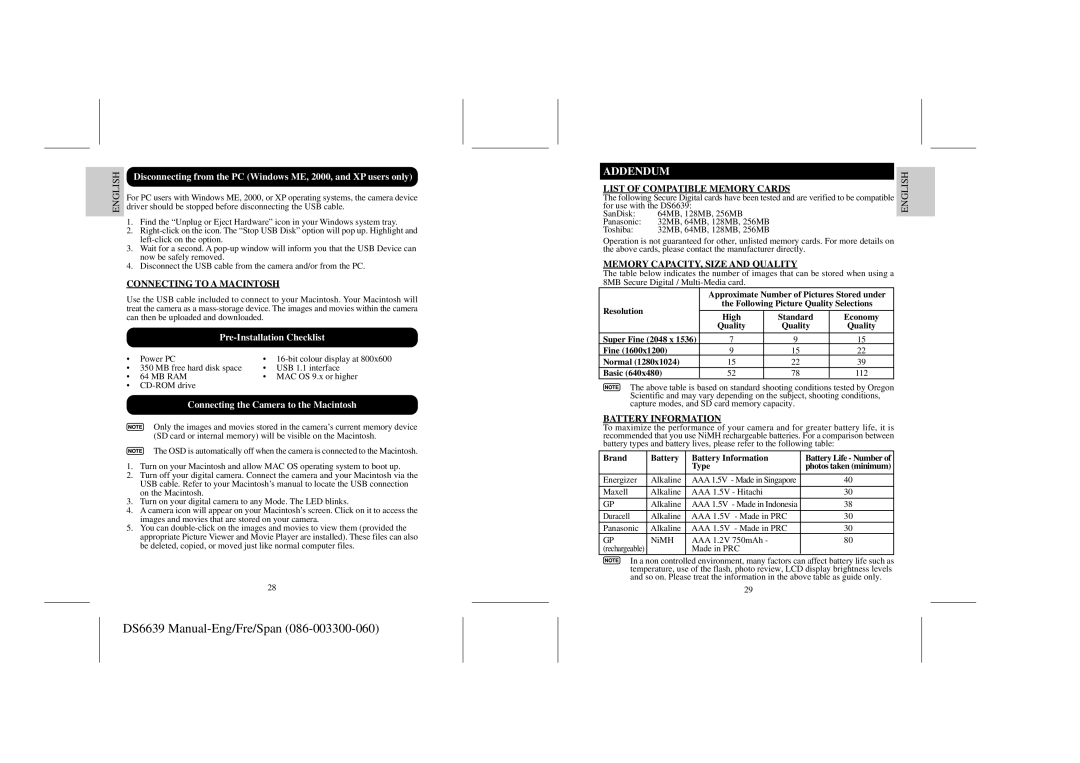
ENGLISH
Disconnecting from the PC (Windows ME, 2000, and XP users only)
For PC users with Windows ME, 2000, or XP operating systems, the camera device driver should be stopped before disconnecting the USB cable.
1.Find the “Unplug or Eject Hardware” icon in your Windows system tray.
2.
3.Wait for a second. A
4.Disconnect the USB cable from the camera and/or from the PC.
CONNECTING TO A MACINTOSH
Use the USB cable included to connect to your Macintosh. Your Macintosh will treat the camera as a
Pre-Installation Checklist
• | Power PC | • | |
• 350 MB free hard disk space | • | USB 1.1 interface | |
• | 64 MB RAM | • | MAC OS 9.x or higher |
•
Connecting the Camera to the Macintosh
Only the images and movies stored in the camera’s current memory device (SD card or internal memory) will be visible on the Macintosh.
The OSD is automatically off when the camera is connected to the Macintosh.
1.Turn on your Macintosh and allow MAC OS operating system to boot up.
2.Turn off your digital camera. Connect the camera and your Macintosh via the USB cable. Refer to your Macintosh’s manual to locate the USB connection on the Macintosh.
3.Turn on your digital camera to any Mode. The LED blinks.
4.A camera icon will appear on your Macintosh’s screen. Click on it to access the images and movies that are stored on your camera.
5.You can
28
ADDENDUM
LIST OF COMPATIBLE MEMORY CARDS
The following Secure Digital cards have been tested and are verified to be compatible for use with the DS6639:
SanDisk: | 64MB, 128MB, 256MB |
Panasonic: | 32MB, 64MB, 128MB, 256MB |
Toshiba: | 32MB, 64MB, 128MB, 256MB |
Operation is not guaranteed for other, unlisted memory cards. For more details on the above cards, please contact the manufacturer directly.
MEMORY CAPACITY, SIZE AND QUALITY
The table below indicates the number of images that can be stored when using a 8MB Secure Digital /
| Approximate Number of Pictures Stored under | |||
Resolution | the Following Picture Quality Selections | |||
|
|
| ||
High | Standard | Economy | ||
| ||||
| Quality | Quality | Quality | |
|
|
|
| |
Super Fine (2048 x 1536) | 7 | 9 | 15 | |
Fine (1600x1200) | 9 | 15 | 22 | |
Normal (1280x1024) | 15 | 22 | 39 | |
Basic (640x480) | 52 | 78 | 112 | |
The above table is based on standard shooting conditions tested by Oregon Scientific and may vary depending on the subject, shooting conditions, capture modes, and SD card memory capacity.
BATTERY INFORMATION
To maximize the performance of your camera and for greater battery life, it is recommended that you use NiMH rechargeable batteries. For a comparison between battery types and battery lives, please refer to the following table:
Brand | Battery | Battery Information | Battery Life - Number of | |
|
| Type |
| photos taken (minimum) |
|
|
|
| |
Energizer | Alkaline | AAA 1.5V - Made in Singapore | 40 | |
|
|
|
| |
Maxell | Alkaline | AAA 1.5V - Hitachi | 30 | |
GP | Alkaline | AAA 1.5V - Made in Indonesia | 38 | |
Duracell | Alkaline | AAA 1.5V | - Made in PRC | 30 |
Panasonic | Alkaline | AAA 1.5V | - Made in PRC | 30 |
GP | NiMH | AAA 1.2V 750mAh - | 80 | |
(rechargeable) |
| Made in PRC |
| |
In a non controlled environment, many factors can affect battery life such as temperature, use of the flash, photo review, LCD display brightness levels and so on. Please treat the information in the above table as guide only.
29
ESPAÑOL FRANÇAIS ENGLISH
